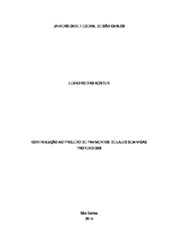| dc.contributor.author | Küster, Leandro Dias | |
| dc.date.accessioned | 2016-09-26T20:37:44Z | |
| dc.date.available | 2016-09-26T20:37:44Z | |
| dc.date.issued | 2015-04-27 | |
| dc.identifier.citation | KÜSTER, Leandro Dias. Contribuição ao projeto de pavimentos de lajes sem vigas protendidas. 205. Dissertação (Mestrado em Engenharia Civil) – Universidade Federal de São Carlos, São Carlos, 205. Disponível em: https://repositorio.ufscar.br/handle/ufscar/7457. | * |
| dc.identifier.uri | https://repositorio.ufscar.br/handle/ufscar/7457 | |
| dc.description.abstract | Prestressed flat plate floor system has been an excellent structural solution for
building work when there is a demand for fast construction with less manpower,
where the building has height restrictions or when architecture design requires wide
environments and major deformations on the floor can be avoided. Aspects like
these, make the use of this structural system grow constantly. Although there are
cases of built constructions, some structural engineers still feel uncomfortable to use
the system, because beyond the scarcity of bibliography on this matter, most of the
problems are solved by intuition, and not with technical-cientific knowledge. This
research presents fundamental concepts for understanding the prestressed flat plate
floor system, as well the designing methods. A comparison of the tensile stress in the
slabs is also made, envolving the Equivalent Frame Method, the Finite Element
Method and the Grillage Method. The effect of the lack of alignment also is studied.
In sequence, examples of prestressed flat plate floor are shown and their structural
solutions, using adherent and non-adherent cables, using partial prestress and
reduced prestress. At the end of this research comments are made about the
obtainned results and suggestions of structural solutions are presented for specific
problems that occur frequently. | eng |
| dc.description.sponsorship | Não recebi financiamento | por |
| dc.language.iso | por | por |
| dc.publisher | Universidade Federal de São Carlos | por |
| dc.rights.uri | Acesso aberto | por |
| dc.subject | Construção civil | por |
| dc.subject | Lajes sem vigas | por |
| dc.title | Contribuição ao projeto de pavimentos de lajes sem vigas protendidas | por |
| dc.type | Dissertação | por |
| dc.contributor.advisor1 | Carvalho, Roberto Chust | |
| dc.contributor.advisor1Lattes | http://lattes.cnpq.br/3633394168236221 | por |
| dc.description.resumo | A laje sem viga protendida tem sido uma excelente solução estrutural para
obras onde precisa-se construir rapidamente, onde a altura do edifício possui
restrições ou quando a arquitetura não permite pilares alinhados. Aspectos como
esses fazem com que a utilização desse sistema estrutural esteja em constante
crescimento. Apesar de já se ter um histórico de obras construídas, alguns
construtores ainda se sentem desconfortáveis para utilizar o sistema, pois além de
não se ter muita bibliografia na área, muitos dos problemas são resolvidos pela
intuição, e não por conhecimento técnico-científico. O presente trabalho apresenta
conceitos fundamentais para o entendimento do sistema de lajes sem vigas
protendidas, bem como métodos de dimensionamento. Também é feita uma
comparação de esforços nas lajes, envolvendo o Método dos Pórticos Equivalentes,
o Método dos Elementos Finitos e Analogia de grelhas. Na seqüência do trabalho
são apresentados exemplos de pavimentos sem vigas protendidos e soluções
estruturais dos mesmos, utilizando armadura aderente e não aderente, utilizando
protensão parcial e protensão limitada. Ao final do trabalho são apresentadas
sugestões de soluções estruturais para problemas específicos que ocorrem com
freqüência. | por |
| dc.publisher.initials | UFSCar | por |
| dc.publisher.program | Programa de Pós-Graduação em Engenharia Civil - PPGECiv | por |
| dc.subject.cnpq | ENGENHARIAS::ENGENHARIA CIVIL::CONSTRUCAO CIVIL | por |
| dc.ufscar.embargo | Online | por |
| dc.publisher.address | Câmpus São Carlos | por |
| dc.contributor.authorlattes | http://lattes.cnpq.br/0718993595233743 | por |
